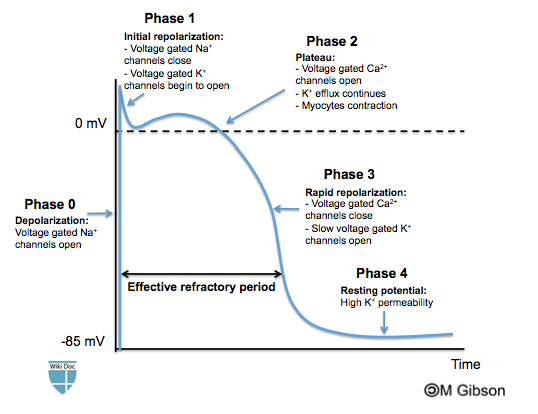WBR1015
Jump to navigation
Jump to search
| Author | [[PageAuthor::Rim Halaby, M.D. [1] (Reviewed by Serge Korjian)]] |
|---|---|
| Exam Type | ExamType::USMLE Step 1 |
| Main Category | MainCategory::Physiology |
| Sub Category | SubCategory::Cardiology |
| Prompt | [[Prompt::A pharmaceutical company is developing a new anti-arrhythmic drug that targets the slow voltage gated potassium channels. During which of the following phases of the action potential (depicted below) is this drug most active? |
| Answer A | AnswerA::A |
| Answer A Explanation | AnswerAExp::A corresponds to phase 0 of the ventricular action potential. Phase 0 is characterized by a depolarization caused by the abrupt opening of the voltage gated sodium channel. |
| Answer B | AnswerB::B |
| Answer B Explanation | AnswerBExp::B corresponds to phase 1 of the ventricular action potential. Phase 1 is characterized by an early repolarization caused by the closure of the sodium channels and the opening of voltage gated potassium channels. |
| Answer C | AnswerC::C |
| Answer C Explanation | AnswerCExp::C corresponds to phase 2 of the ventricular action potential. Phase 2 is characterized by a plateau. The plateau results from the opening of the voltage gated calcium channels leading to an influx of calcium that balances the potassium efflux. |
| Answer D | AnswerD::D |
| Answer D Explanation | AnswerDExp::D corresponds to phase 3 of the ventricular action potential. Phase 3 is characterized by a rapid repolarization caused by the closure of the calcium channels and opening of the slow voltage gated potassium channel. |
| Answer E | AnswerE::E |
| Answer E Explanation | AnswerEExp::E corresponds to phase 4 of the ventricular action potential. Phase 4 is characterized by a resting potential which is caused by the high potassium permeability through the potassium channels. |
| Right Answer | RightAnswer::D |
| Explanation | [[Explanation::The ventricular action potential is composed of four phases:
The image below details the different phases of the ventricular action potential.
|
| Approved | Approved::Yes |
| Keyword | WBRKeyword::Action potential, WBRKeyword::Antiarrhythmics, WBRKeyword::Phase 3, WBRKeyword::Calcium channels, WBRKeyword::Potassium chanels, WBRKeyword::Mechanism of action |
| Linked Question | Linked:: |
| Order in Linked Questions | LinkedOrder:: |

